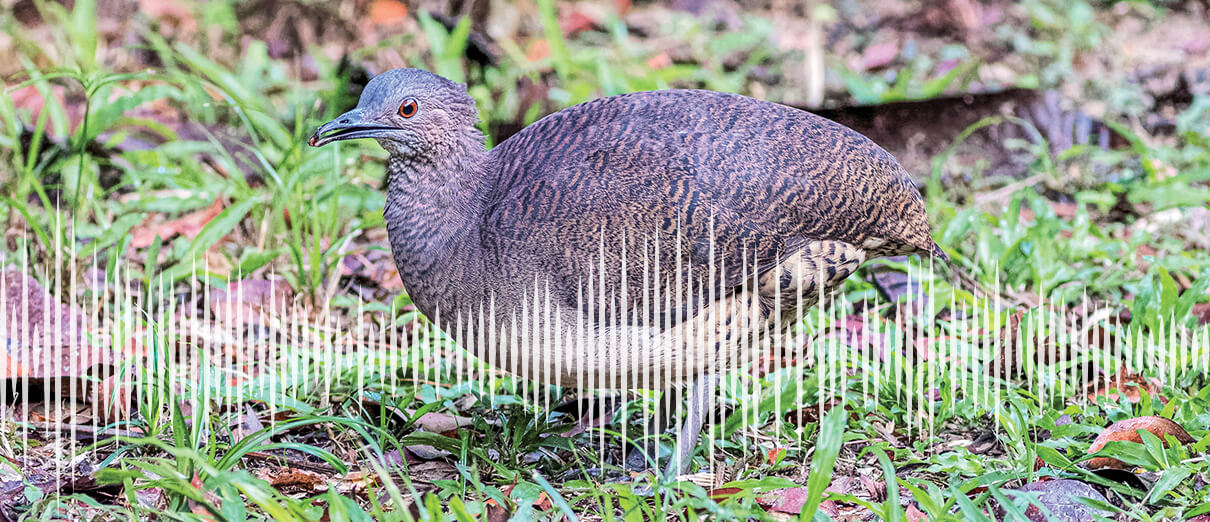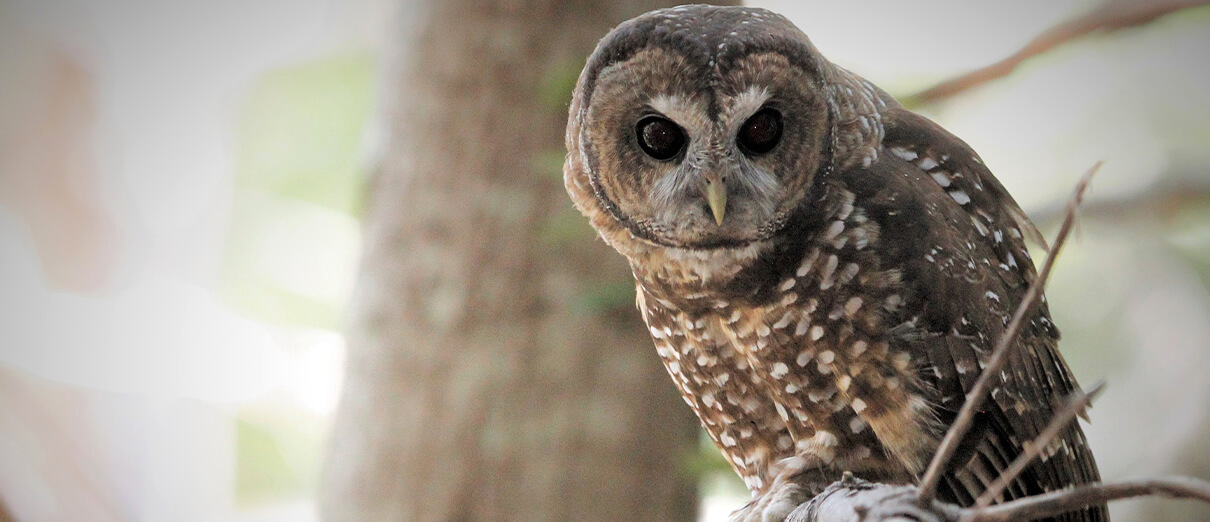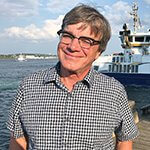Saving Birds with Sound
Above Kaua‘i's remote northwest coast, an unlikely whine fills the air. A helicopter glides out of the sky and hovers just above impassable, 3,000-foot-high cliffs that are preferred nesting grounds for the world's remaining colonies of the Newell's Shearwater and Hawaiian Petrel. The seabirds, endemic to Hawai‘i, face pressure from all sides. Development has carved up much of their habitat. Predators from feral cats to wild pigs kill thousands of the birds every year. And powerlines and urban lights on the island often prove deadly.
The chopper helps biologists keep tabs on the health of remote seabird populations. Distributed among the colonies here are dozens of textbook-sized bioacoustic sound meters, placed there before the birds returned to nest. No part of the treacherous terrain is out of reach. These devices record vocalizations until nesting season ends. Then, it's time to deploy the helicopter to collect them for their sound data. Dangling from 100 feet of rope, a grappling hook descends from the stationary chopper until it snags and carefully lifts a three-pound wooden basket containing a sound meter.

Newell's Shearwater chick by André Raine/KESRP
Innovation, in the Nick of Time
More than 94 percent of the shearwaters and 78 percent of the petrel population had vanished by the time the Kaua‘i Endangered Seabird Recovery Project heard about sound meter recording and processing technology in 2012. They thought this new innovation might help with a rescue plan they were drawing up with partners, including ABC. The new technology and techniques are part of a developing field called bioacoustics. As its name suggests, bioacoustics couples life sciences with acoustics, using sound to study the environment. It has its roots in tracking submarines and whales. In the last decade, the precision of bioacoustics accelerated with advances in digital sound and machine learning. It has proven a particularly effective tool for researching nocturnal and cryptic birds, since most species, seabirds among them, are so vocal. Among bioacoustics' great advantages: Allowing scientists to monitor sensitive bird species without disturbing them — and reaching places people can't.
“This was the missing piece of the puzzle for monitoring the colony,” says André Raine, project coordinator for the recovery program, which works with a consortium of government, university, and nonprofit organizations on a state-of-the art conservation mission. ABC and Conservation Metrics have been key partners in this work. The strategy includes battling predators, building impenetrable fences to cordon off the seabird colonies, negotiating with utilities over powerline remediation, and constantly tracking progress to guide the work.

Song meters are deployed to remote Kaua'i seabird colonies via helicopter. Photo by André Raine/KESRP
After the sound meter data is collected by helicopter pickup and data gets back to the Conservation Metrics lab in California, the analyses track key indicators such as population counts, predator encounters, even levels of breeding success.
"These little units are just fantastic for this," says Hannah Nevins, Seabird Program Director for ABC, who has been part of the project. Eight years after bioacoustics first went into place in Hawai‘i, researchers are seeing, through bioacoustics monitoring, that their recovery efforts caused decided shifts in the health of the seabird species. Breeding is up significantly as a result of predator control, and song meters are indicating increases in activity around the colony.
The approach is now also being used on far-flung, uninhabited Nihoa Island, where ABC researchers use sound meters to search for potential breeding grounds of the Bryan's Shearwater, a Critically Endangered species with an estimated population of fewer than 250 adult birds.
The outcomes in Hawai‘i are among the most impressive in a long list of projects worldwide that integrate bioacoustics. Scientists are asking a new question: How far can this field of study go toward reshaping avian research and conservation?
As with any scientific question, there's no shortage of opinions on the subject. Some say that, as can be the case with new technologies, the promise is overstated. Skeptics worry about the accuracy of deciphering the tens of thousands of bird calls by machine. Others say the use of sound is only suitable for select situations where birds are the most vocal and the sound clearest. Not all scientists are adopting the new technology, particularly some researchers committed to traditional field observation. But a new wave of scientists growing up on digital tools certainly is taking to them.
"The next generation is definitely using this more because they're more comfortable with technology and programming," says ABC's Nevins. "There are always going to be people who are early adoptors, and those who never change because that's how they've always done it."
Those who work with bioacoustics say these are early days with these techniques — and that they are evolving rapidly. And they say that traditional field work based on human observation will always be important. But when bioacoustics is added, the result is a potent combination with greatly expanded reach, particularly in remote parts of the world.
"I'm well aware that you can talk to any scientist from any time period and they'll say we're right on the cusp of something extraordinary," says Justin Kitzes, a computational ecologist with the University of Pittsburgh. "But there's a convergence of a lot of things right now that in the next 20 years are going to be very important."

Bioacoustics equipment is being used to study endangered tinamous in the Peruvian Andes. Photo: Undulated Tinamou by Reid Rumelt
From Detecting Subs to a Digital Revolution
Bioacoustics' origins date back to military experiments tracking enemy submarines during the First World War. For years after, sound research was used mostly in the ocean, including monitoring whales by their haunting songs. The results were mixed, often hindered by rudimentary equipment and the difficulty of analyzing hours upon hours of recordings.
Dan Saenz, now a research wildlife biologist with the U.S. Forest Service in Texas, was among the first to apply bioacoustics to wildlife on land. About 20 years ago, he built his first sound meter in his garage, using a plastic tool box and parts from a nearby electronics store.
"It was really primitive," he says, and so was his method for analyzing the audio. "I would take it home at night and listen to them (the recordings) and write the results down on a pad."
The technology began to improve with the digital era. The big leap forward came over the last decade as Google and Facebook shared the algorithms they developed for web searches. Suddenly, researchers could sort reams of data instantly with the help of artificial intelligence.
"That really unleashed the power of these recordings," says Holger Klinck, Director of the Center for Conservation Bioacoustics at the Cornell Lab of Ornithology and a leader in the field. Cornell saw the potential for bioacoustics to greatly boost avian research and not only created the center, but built equipment, began working with partners, and shared its findings for free. Now dozens of projects are in the works. As the field matures, the lab is sharing its work and breakthroughs in an open-source culture.
The process is fairly simple, starting with converting the bird calls under study into digital imprints called spectrographs. "You make a spectrograph of the sound you're looking for," says Matthew McKown, whose company Conservation Metrics provides equipment and computational analyses for the Kaua‘i team and many researchers around the world. "Then you slide that template over the background sound and it flags whenever there's a correlation."
Researchers from the University of California at Davis are using bioacoustics to study the impacts of forest fires on bird populations in the West. In Florida, the U.S. Air Force uses song meters to study how federally listed Red-cockaded Woodpeckers, Florida Grasshopper Sparrows, and Florida Scrub-Jays are affected by military maneuvers. In Pittsburgh, the Powdermill Nature Reserve is using song meters to collect flight calls to study migration, long a problematic research subject because so much happens at a distance and at night.
Some of the most elusive birds are now in scientists' sights. For example, bioacoustics equipment aids an ornithologist as he studies skulking, endangered tinamous in the Peruvian Andes, and researchers in the Pacific Northwest use bioacoustics to understand breeding patterns of the federally Threatened Marbled Murrelet, a tree-nesting seabird that until now had been almost impossible to track, and to census the old-growth-reliant Northern Spotted Owl, a federally Threatened subspecies declining from habitat loss and competition with range-expanding Barred Owls.

Northern Spotted Owl by Michael J. Parr
Following a series of studies in the past year alone that document a developing crisis in avian populations, calls for research are growing. Scientists say there's an imperative need for new and economical approaches to research and targeted conservation.
"There's a lot of research in front of us," says John Fitzpatrick, Director of the Cornell Lab, who is a big supporter of bioacoustics. "This will be profoundly important."
READ MORE: Bioacoustics Make Life Better for Birders
As John Fitzpatrick, Director of the Cornell Lab, puts it: "If I had a dollar for every time somebody asked me when we're going to have a Shazam for birds, I'd be able to fund all this research with that alone."
That day is finally coming: Cornell released an app for Android phones last year that uses the same technology the lab developed to record and identify species for research. BirdNET, which has been downloaded about a half a million times, is expected to come out for Apple phones this year. It may be incorporated into the existing Cornell bird identification app Merlin.
Cornell has now developed identification materials for 6,000 of the world's 10,000 or so species. The lab makes its technology available to all. With growing sound libraries and improving technology, birders can expect Cornell, as well as its partners and competitors, to continuously improve their apps.
A more complex identification tool that uses the same research tools is in the works. It will enable birders to use bioacoustics to track all the birds nearby, say in their yards, on a real-time basis. This project, which Cornell now has in development with Florida-based Loggerhead Instruments, will collect all the bird songs and calls and send identification lists to your computer.
The device, which should be available within the year, will be called a Haikubox, and will be built to look like a wooden birdhouse. Its reach will depend upon ambient noise, wind levels, and song volume, but it should be able to identify birds from 300 to 600 feet away, according to Holger Klinck, Director of Cornell's Center for Conservation Bioacoustics.
These products should add a new dimension to the bird identification race. At the same time, the data collected will be shared with Cornell, adding to the reach and power of the lab's research, boosting what we know about bird movement and distribution.
— Anders Gyllenhaal
Comebacks Via Playback
Projects using bioacoustics are now moving from basic bird counts to more complex research goals.
At the University of Pittsburgh, researchers are experimenting with ways to compute exactly where all the birds are in their environments. They've built a giant grid of recorders that picks up relative volumes of calls and songs. Then they use the differences in sound volume to calculate bird locations. They plan to build a graphic in which color-coded bubbles representing birds will pop up as you move over the map.
In one experiment in Latin America, Cornell researchers deploy sound meters to study how birds react to different coffee-farming approaches: how birds do in shady versus sunny environments, for instance. They hope the findings will lead to the best farming practices to provide a healthy environment for birds without curbing coffee output.
Ornithologists have turned the sound meter concept around to use broadcasts of bird vocalizations to lure species back to former, or into new, habitat by coaxing them into thinking they were joining others of their kind. With these techniques, conservationists attracted Atlantic Puffins back to Maine nesting islands, drew back Peruvian Diving-petrels to a Chilean reserve, and, just this year, helped to relocate a tern and gull nesting colony displaced by bridge construction in Hampton Roads, Virginia.
Although advancing quickly, bioacoustics has lagged behind such related fields as voice recognition and digital search, which have commercial applications to fund their research. That, too, may change with more sophisticated use of sound. As the economics and precision of bioacoustics improve, observers expect to see uses that go beyond research. Among other potential applications for bioacoustics: monitors that listen for factory machinery and at-home appliance malfunctions; devices that can help the blind navigate their surroundings; and sound meters that help detect threats to birds and their habitats, such as poaching, by monitoring the sounds of gunshots and chainsaws.

Recorders have greatly improved efforts to census Northern Spotted Owls and other secretive birds. Photo by Connor Wood
Soundscape Libraries
The greatest potential for bioacoustics in conservation, says Cornell's Klinck, is for monitoring environments in parts of the world where little is known about the health of species. "It's all about developing these methods that allow us to do a comprehensive job in assessing what's going on in these remote areas," he says. "That's the end goal."
When they look into the future, scientists envision a time when taking soundscapes will be so economical and routine as to become as commonplace as weather data. The recordings, they say, will become like books, maintained over time on many public platforms and checked out for all kinds of research projects.
"These data will be the museum specimens of our century," says the University of Pittsburgh's Justin Kitzes. "These are things we should be archiving. Future generations will return to them, with better methods, better equipment, and new questions we can't even think of today. They are going to be very thankful to us for preserving this."
Bioacoustics can also be a tool to build public support for conservation. Much of the soundscapes of endangered species are in exotic places, where the sounds alone could be a powerful, accessible educational tool.
André Raine will always remember the day he struggled through the thick underbrush on Kaua‘i to reach the top of a cliff in the Hono O Nā Pali Natural Area Reserve, where he found the largest Hawaiian Petrel colony he'd ever seen. "It was absolutely amazing," he says. "There were birds everywhere, like going back in time."
The sound of such scenes could help make the case for conservation, say researchers. ABC's Nevins, who works on the Hawai‘i project, sees a day when capturing that cacophony would help the cause. "Can we bring some of this back to share as an educational experience, so people can hear what it sounds like?" she asks.
Meanwhile, back in the field, bioacoustics continues to change the game for many researchers, including Connor Wood, a Ph.D. candidate at the University of Wisconsin. Wood censuses the Northern Spotted Owl in the expansive Sierra Nevada mountains. "We can cover thousands of square miles," he says. "The data is just raw sound, so it's up to you as a scientist to be creative and think, 'How can I get the most out of this data?' I think it can be a really powerful way to both advance the species' conservation and conduct the basic science."
 | Anders Gyllenhaal is a veteran journalist and former top editor of The Miami Herald, Minneapolis Star Tribune, and Raleigh News & Observer. He serves on ABC's Board of Directors. |


















































